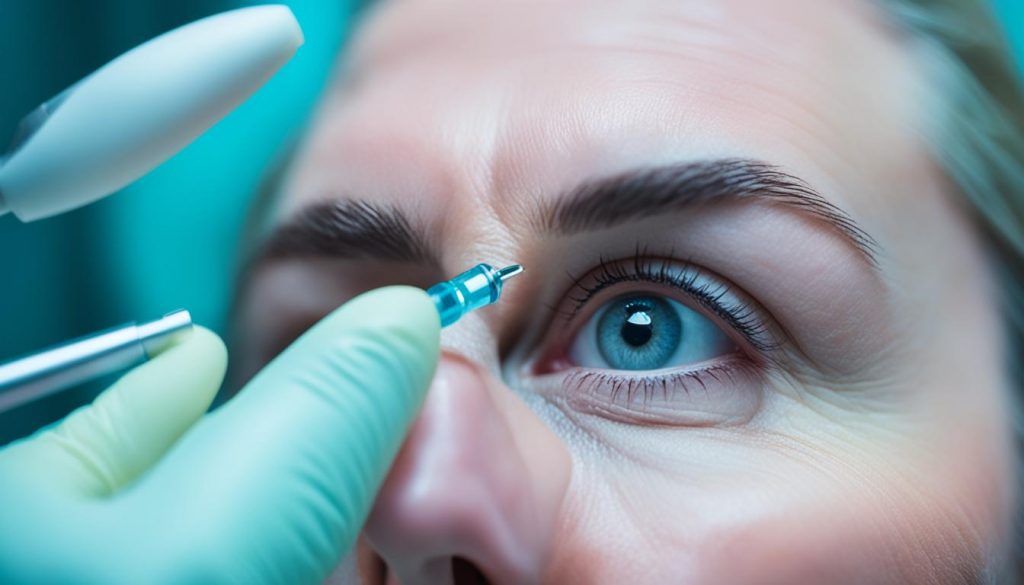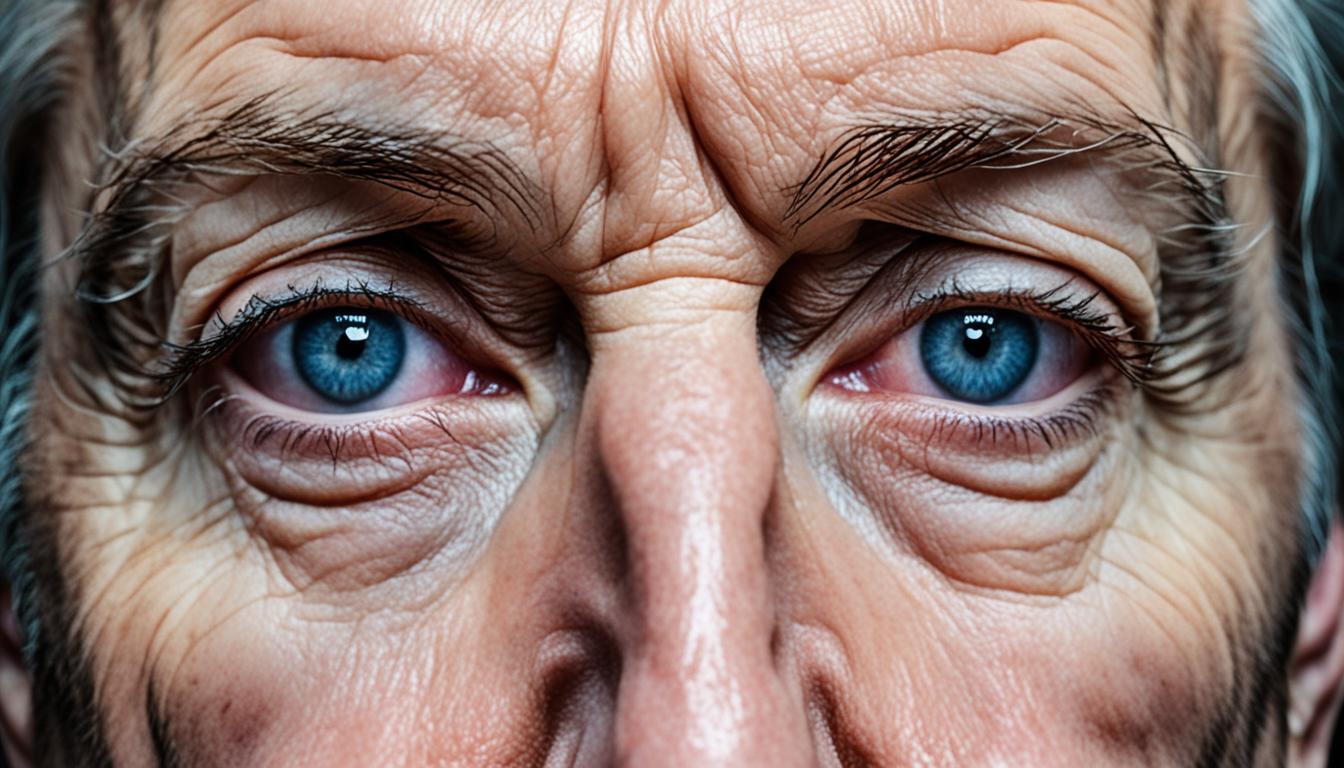Bags under eyes, or eye bags, mainly worry older adults. They show up as slight swelling or puffiness below the eyes. This often comes with saggy skin and dark circles. Although mostly not serious, they can signal health issues sometimes. Treatments range from simple at-home care to surgeries. Recently, stem cell therapy has been gaining attention for tackling the core reasons behind eye bags.
Key Takeaways:
- Bags under eyes are a cosmetic concern characterized by mild swelling or puffiness beneath the eyes.
- They can be accompanied by sagging or loose skin and dark circles.
- In some cases, bags under the eyes may indicate underlying medical conditions.
- Treatment options include home remedies, medical interventions, and surgical procedures.
- Stem cell therapy is an emerging treatment option for addressing the root causes of eye bags.
What are eye bags?
Eye bags, also known as eye puffiness, happen when the eye’s surrounding tissues weaken. This issue is mainly due to age. The muscles and fat under the eyes can’t hold up, making the fat move down. This creates puffiness. Also, fluid can gather below the eyes. This makes them swell more. Though eye bags are mostly about looks, there are ways to treat them at home. For tough cases, surgery might be suggested.
Eye bags come from muscles and fat getting weaker around the eyes. As we get older, this issue becomes more noticeable. The fat then goes lower into the eyelid, showing as puffiness. Also, fluid can increase under the eyes. This adds to the swollen look. So, it’s all about the changes around your eyes.
Eye bags mostly affect how we look. They can make someone feel bad about their appearance. Bags under the eyes can make one seem tired or older. Luckily, there are ways to fix this issue.
For a non-surgical fix, try simple home remedies. Use cool compresses, cut down on salt, and get plenty of sleep. These steps can lessen the puffiness. Plus, makeup can hide eye bags for a while.
But, if eye bags are a big problem, surgery might be the answer. This surgery removes the extra skin and fat, making the eyes look younger. It’s a significant and lasting solution for those looking for a change.
Eye bags are common and can happen for many reasons, like aging and fluid build-up. You can try home solutions, but sometimes surgery is needed. It’s key to talk with a healthcare pro to find the best option for you.
Symptoms and causes of eye bags
Eye bags show symptoms like mild swelling and dark circles. Loose skin under the eyes is also a common sign. If eye bags stay or get worse, they may point to health problems. Thyroid disease and allergies can be linked to them. Eye bags develop for reasons like fluid retention and genetics. Smoking habits and aspects of your lifestyle, such as not enough sleep and too much salt, also matter. Recognizing these signs and reasons is key to dealing with eye bags well.
Below is a table summarizing the symptoms and causes of eye bags:
| Symptoms | Causes |
|---|---|
| Mild swelling | Fluid retention |
| Sagging or loose skin | Genetics (family history) |
| Dark circles | Habits like smoking |
| Lifestyle factors such as lack of sleep and excessive salt intake | |
| Potential underlying medical conditions like thyroid disease and allergies |
Please refer to the image below for a visual representation of eye bags:
Understanding and spotting the symptoms are vital steps. This way, people can address and manage eye bags effectively.
Treatment options for eye bags
Please note that the table and image formatting can only be displayed properly in an HTML viewer.
Treating eye bags offers many choices, from simple home remedies to surgeries. The best treatment depends on how severe the eye bags are and what you prefer. Here are some options for treating eye bags:
Home remedies
Home remedies are a good first step to make eye bags look better. They might not get rid of eye bags fully but can make them less noticeable. Some popular home remedies include:
- Applying cool compresses to the under-eye area to reduce puffiness and swelling.
- Getting enough sleep and rest to minimize fluid retention and prevent fatigue.
- Reducing salt intake to avoid water retention, which can contribute to the appearance of eye bags.
Home remedies might offer quick relief but are less effective for serious eye bags.
For those looking for more noticeable results, there are many medical and surgical treatments available:
Medical treatments
Medical treatments aim to lessen puffiness and improve how the under-eye area looks. Some options include:
- Prescription allergy medications: These can reduce allergies, which sometimes cause eye bags.
- Wrinkle treatments: Laser resurfacing, chemical peels, and fillers can smooth the under-eye area and make eye bags less obvious.
- Topical creams: Creams and serums with retinol or caffeine can tighten the skin and decrease puffiness.
Surgical treatments
If home and medical treatments don’t work, eyelid surgery might be an option. This surgery gets rid of extra skin and fat, tightens muscles, and adjusts the tissues for a younger look. It’s usually advised for severe or chronic eye bags.
It’s important to talk to a healthcare provider to figure out the best treatment for you. They can look at your unique situation and suggest treatments based on what you need and want.

| Treatment Option | Description |
|---|---|
| Home Remedies | Non-invasive approaches like cool compresses, sleep, and cutting back on salt. |
| Medical Treatments | Options include allergy medications, wrinkle treatments, and skin creams. |
| Surgical Treatments | Blepharoplasty for tough or longstanding eye bags. |
Lifestyle and home remedies for eye bags
Many people worry about eye bags as a cosmetic issue. Luckily, simple lifestyle changes and home remedies exist. These can lessen eye bags and enhance the look of the under-eye area.
Cool Compress
Using a cool compress can temporarily lessen eye bags. It helps by making blood vessels smaller and reducing swelling. Just wrap ice cubes in a cold washcloth. Gently press it against your closed eyes for a few minutes every day.
Fluid and Salt Reduction
Cutting down on fluids and salt before bedtime can prevent fluid retention. This retention often leads to eye bags. Eat less salt and drink more water during the day. This can help get rid of extra fluid and decrease puffiness.
Get Enough Sleep
Not sleeping enough can make eye bags look worse. Try to sleep well and keep to a steady sleep schedule. Sleeping with your head raised by an extra pillow can keep fluid from gathering under your eyes.
Allergy Prevention
Allergies can make your eyes irritated and lead to eye bags. Try to stay away from common allergens like dust, pollen, and pet dander. Keep your home clean, use bedding that doesn’t cause allergies, and maybe use an air purifier to clean the air.
Cosmetics
If you need to hide eye bags fast, cosmetics can help. Choose a concealer that matches your skin to cover under-eye discoloration. Cosmetics that reflect light can make the skin look smoother. Remember to be gentle when applying makeup to avoid irritating the eye area.
Good Overall Eye Hygiene
Keeping your eyes clean is key to reducing eye bags. Don’t rub or touch your eyes too much, as it can cause more swelling. Clean your eyelids and lashes to remove makeup or debris that could lead to eye bags.
These lifestyle changes and home remedies can really help with eye bags. They are simple to do and, along with other treatments, can refresh your look.
Stem cell therapy for eye bags
Stem cell therapy is a new and exciting way to treat eye bags. It uses the healing powers of stem cells to fix the issue. These cells come in many types, such as embryonic and induced pluripotent stem cells.
These cells work by regenerating damaged eye tissue. They release special particles called exosomes. These particles help by reducing swelling and protecting nerve cells.
Even though this therapy is still being studied, it’s very promising. It could soon offer a lasting solution for eye bags and other eye problems. This is because stem cells can repair and heal eye tissue well.
Benefits of Stem Cell Therapy for Eye Bags
- Promotes tissue regeneration in the ocular area
- Restores damaged ocular tissue and functional cells
- Reduces inflammation and provides neuroprotection
- Potential for long-lasting and effective results
- Minimally invasive treatment option
- Offers hope for individuals with severe or persistent eye bags
Research into stem cell therapy is ongoing. This treatment could offer a new way to handle eye bags without surgery. By using stem cells, scientists hope to create better treatments for people looking for a reliable fix.
Conclusion
Eye bags, or bags under eyes, are a common sight, especially as we get older. They’re often not serious. But if they’re bad or don’t go away, they can be a sign of health problems. There are many ways to handle eye bags, from simple home tricks to doctor visits.
Simple steps like using a cold compress, drinking less before bed, and sleeping well can make a difference. For tougher cases, doctors might suggest medicine for allergies or ways to deal with wrinkles. Some might need surgery, called blepharoplasty, to fix persistent eye bags.
There’s new hope with stem cell therapy for fixing eye bag issues at their root. This research could change how we treat eye bags, making solutions last longer. Because stem cells can heal damaged eye areas, they’re a beacon of hope for better treatments in the future.

